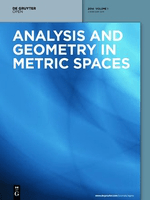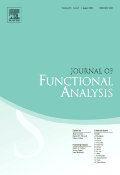
COMMUNICATIONS IN ANALYSIS AND GEOMETRY
Scope & Guideline
Elevating Scholarly Discourse in Mathematics
Introduction
Aims and Scopes
- Geometric Analysis:
Exploration of the geometric properties of manifolds and their invariants, with a particular emphasis on curvature, topology, and their implications for differential equations. - Partial Differential Equations (PDEs):
Investigation of the relationship between geometry and PDEs, including the study of elliptic and parabolic equations in geometric contexts. - Riemannian and Kähler Geometry:
Focused research on Riemannian metrics, Kähler manifolds, and their applications in theoretical physics and complex geometry. - Singularities and Flows:
Analysis of geometric flows and singularities, including mean curvature flow and Ricci flow, and their geometric and topological consequences. - Topology and Knot Theory:
Study of topological properties of manifolds and knot theory, exploring relationships between different geometrical structures. - Metric Geometry:
Research on metric spaces and their geometric properties, including applications to various areas of mathematics such as analysis and topology.
Trending and Emerging
- Geometric Flows:
An increasing number of publications are dedicated to geometric flows, particularly mean curvature and Ricci flows, highlighting their significance in understanding manifold topology and geometry. - Asymptotic Analysis and Metrics:
Research on asymptotic behaviors of geometric structures and metrics is gaining traction, especially in the context of general relativity and mathematical physics. - Nonlinear Analysis:
Emerging themes in nonlinear analysis, particularly with applications to geometric problems, are becoming more prominent, reflecting a broader interest in complex systems. - Symmetry and Invariance in Geometry:
A growing focus on symmetry in geometric contexts, particularly regarding solutions to equations on manifolds and their implications, indicates a trend towards exploring invariance properties. - Higher Dimensional Geometry:
Research in higher-dimensional geometries is on the rise, with studies exploring complex manifolds and their applications in various mathematical and physical theories.
Declining or Waning
- Classical Differential Geometry:
While still relevant, traditional topics in differential geometry have seen a decrease in focus, possibly due to the growing interest in more complex geometric structures and flows. - Elementary Algebraic Geometry:
The study of basic algebraic structures and their geometric interpretations appears to be waning, as the journal shifts towards more advanced and nuanced topics in geometry and analysis. - Basic Topological Properties:
Fundamental studies in topology, especially those not directly linked to geometric analysis, are becoming less frequent, indicating a move towards more applied or complex topological investigations.
Similar Journals

International Electronic Journal of Geometry
Empowering Researchers with Open Access KnowledgeWelcome to the International Electronic Journal of Geometry, an esteemed platform dedicated to the dissemination of high-quality research in the fields of geometry, applied mathematics, and mathematical physics. Published by the INT ELECTRONIC JOURNAL GEOMETRY based in Ankara, Turkey, this journal serves as a crucial resource for scholars and practitioners eager to contribute to and stay informed on contemporary advancements in these disciplines. While currently categorized in the Q4 Quartile across multiple mathematical categories, the journal has consistently focused on fostering innovative research and providing open access to its content, although specific access options may vary. The International Electronic Journal of Geometry is known for facilitating scholarly dialogue and collaboration, aiming to enhance knowledge exchange within the global mathematical community from 2019 into the future. Whether through rigorous research articles or insightful commentary, this journal plays a vital role in promoting the understanding and application of geometric concepts and mathematical principles.

Journal of Geometry
Connecting Mathematicians through Geometric InnovationJournal of Geometry, published by SPRINGER BASEL AG, is a prominent scholarly journal, ISSN 0047-2468 and E-ISSN 1420-8997, dedicated to the field of Geometry and Topology. Hailing from Switzerland, this journal has been a vital resource for researchers since its inception in 1971 and continues to contribute invaluable insights into geometric theories and applications through 2024. With a HIndex that reflects its academic impact, the journal currently ranks in the Q3 category for Geometry and Topology, placing it within the top half of publications in its field, as evidenced by its Scopus ranking of #71 out of 106 in Mathematics, Geometry, and Topology. The Journal of Geometry serves as a platform for original research, reviews, and special issues that address foundational and cutting-edge topics, making it an essential read for mathematicians, educators, and students alike. While it is not an open-access publication, the journal maintains accessibility through institutional subscriptions, ensuring that its significant contributions to geometry are readily available to the academic community.

EXPOSITIONES MATHEMATICAE
Elevating Mathematical Discourse Across BordersEXPOSITIONES MATHEMATICAE, published by Elsevier GmbH, stands as a significant journal in the realm of mathematics, catering primarily to researchers, professionals, and students. With an ISSN of 0723-0869 and an E-ISSN of 1878-0792, this journal has made its mark in the academic community, boasting a Q2 classification in the miscellaneous mathematics category for 2023, illustrating its prominence within its field. The journal addresses a diverse scope of mathematical topics, encouraging the publication of original research and innovative theories while maintaining rigorous academic standards. As it converges from 2004 to 2024, EXPOSITIONES MATHEMATICAE continues to be an essential resource for advancing mathematical knowledge and fostering scholarly communication, despite being a non-open-access publication. Its location in Munich, Germany further anchors it within a rich intellectual tradition, providing accessibility for the mathematical community worldwide.

Analysis and Geometry in Metric Spaces
Illuminating the path of discovery in metric space theory.Analysis and Geometry in Metric Spaces is a distinguished open-access journal published by DE GRUYTER POLAND SP Z O O, dedicated to advancing the fields of analysis, geometry, and applied mathematics. Since its inception in 2013, the journal has established itself as a vital resource for researchers and practitioners, consistently achieving high rankings in its categories, including Q1 in Analysis and Q2 in Applied Mathematics and Geometry and Topology, with notable Scopus rankings reflecting its impact within the mathematical community. The journal aims to foster scholarly exchange by publishing rigorous research articles that explore innovative trends and significant developments in metric space theory. With continuous open-access accessibility, it ensures that the latest findings are readily available to academics across the globe, thus contributing to the broader discourse within mathematics. As the journal prepares to bridge the years to 2024, it remains committed to serving as a cornerstone for advancements in its scope and a beacon for methodological breakthroughs.

Tamkang Journal of Mathematics
Advancing Knowledge in Applied and Theoretical MathematicsTamkang Journal of Mathematics, published by TAMKANG UNIVERSITY, serves as a vital platform for researchers and professionals in the fields of applied mathematics, general mathematics, and materials science. With an ISSN of 0049-2930 and an E-ISSN of 2073-9826, this journal has established itself within the academic community, particularly noted for its contributions from Taiwan. Although categorized as Q4 in Applied Mathematics and Q3 in multiple related fields according to the 2023 ranking, it maintains a solid reputation for disseminating significant research findings and innovative methodologies. Researchers can explore an array of topics within its pages, making it an excellent resource for enhancing mathematical knowledge and applications. As it converges from 2005 to 2024, the journal invites academics, professionals, and students to engage with its content and contribute to the ongoing dialogue in mathematics and its interdisciplinary applications.

JOURNAL OF FUNCTIONAL ANALYSIS
Fostering Innovation in Mathematical DiscourseThe JOURNAL OF FUNCTIONAL ANALYSIS, published by Academic Press Inc Elsevier Science, stands as a premier platform in the field of analysis, encompassing a broad spectrum of topics pertinent to functional analysis and its applications. With an impressive impact factor and categorized in Q1 for the year 2023, it ranks as one of the top journals in Mathematics (Analysis), placing it in the 77th percentile among its peers. This journal, founded in 1967, continues to provide researchers, professionals, and students with cutting-edge insights, rigorous publications, and a vibrant forum for scholarly discourse. The journal remains committed to advancing knowledge in the discipline and fostering an environment that encourages innovation and collaboration. Although it does not offer open access options, its high standards for publication ensure that each issue is replete with high-quality research that significantly contributes to the field. The journal's comprehensive coverage aligns well with the evolving landscape of functional analysis, making it an indispensable resource for anyone seeking to deepen their understanding and engage with current trends in this essential area of mathematics.

ANNALES DE L INSTITUT FOURIER
Unveiling New Perspectives in Algebra and GeometryANNALES DE L INSTITUT FOURIER is a premier academic journal published by ANNALES INST FOURIER, specializing in the fields of Algebra and Number Theory as well as Geometry and Topology. Since its establishment, the journal has garnered a distinguished reputation, evidenced by its Q1 quartile ranking in the 2023 category assessments and its Scopus Rank of #37 out of 119 in Algebra and Number Theory, and #34 out of 106 in Geometry and Topology, placing it within the top percentile of its field. The journal serves as a vital platform for disseminating groundbreaking research and innovative methodologies, catering to a global audience of researchers, professionals, and students. With a commitment to the advancement of mathematical sciences, ANNALES DE L INSTITUT FOURIER invites contributions that push the boundaries of knowledge and foster collaboration across disciplines. Although it does not offer open access, the rigorous peer-review process ensures that published papers meet the highest academic standards, making it a critical resource for anyone engaged in advanced mathematical research.

Pure and Applied Mathematics Quarterly
Elevating Research in Pure and Applied MathematicsPure and Applied Mathematics Quarterly is a prestigious journal published by INT PRESS BOSTON, INC, focusing on the diverse and evolving field of mathematics. Since its inception in 2007, this journal has grown significantly, currently holding a Q1 ranking in the Mathematics (Miscellaneous) category for 2023, positioning it among the leading publications in the discipline. With a commitment to publishing high-quality research, Pure and Applied Mathematics Quarterly fosters innovation and dialogue within the mathematical community by providing a platform for theoretical advancements and practical applications. The journal remains accessible to researchers and professionals through its ISSN 1558-8599 and E-ISSN 1558-8602, although it does not currently offer open access. As a vital resource for mathematicians, educators, and students, this journal endeavors to expand the frontiers of mathematical knowledge and contribute to the academic dialogue surrounding this fundamental science.

GEOMETRIC AND FUNCTIONAL ANALYSIS
Unveiling Innovations in Analysis and GeometryGeometric and Functional Analysis, ISSN 1016-443X, is a prestigious academic journal published by Springer Basel AG in Switzerland, renowned for its impactful contributions to the fields of geometry and analysis. With a notable Q1 ranking in both Analysis and Geometry and Topology, the journal has established itself as a leading voice in the mathematical community, garnering respect and attention with its Scopus classification — ranking 6th in Geometry and Topology and 26th in Analysis. Since its inception in 1991, it has served as a platform for rigorous research, presenting original articles that push the boundaries of mathematical understanding. Researchers, professionals, and students seeking high-quality, peer-reviewed content in these domains will find valuable insights and developments within its pages. While primarily subscription-based, the journal's extensive reach and influence make it an essential resource for advancing knowledge in geometric and functional analysis.

PUBLICATIONES MATHEMATICAE DEBRECEN
Elevating Knowledge in Mathematics Since 1997Publicationes Mathematicae Debrecen is a renowned international journal published by the University of Debrecen, Institute of Mathematics, situated in Hungary. This journal, with both ISSN 0033-3883 and E-ISSN 2064-2849, has established itself in the field of mathematics since its inception, with coverage extending from 1997 to 2024. Recognized for its rigorous academic standards, it currently holds a Q3 ranking in the mathematics (miscellaneous) category for 2023 and ranks at the 42nd percentile among general mathematics journals in Scopus. Publicationes Mathematicae Debrecen aims to disseminate high-quality research across various areas of mathematics, contributing to the advancement of knowledge and practice in this dynamic field. Although it is not an open-access journal, its readers can access a wealth of scholarly work that addresses both theoretical and applied mathematical issues, making it an invaluable resource for researchers, professionals, and students alike.